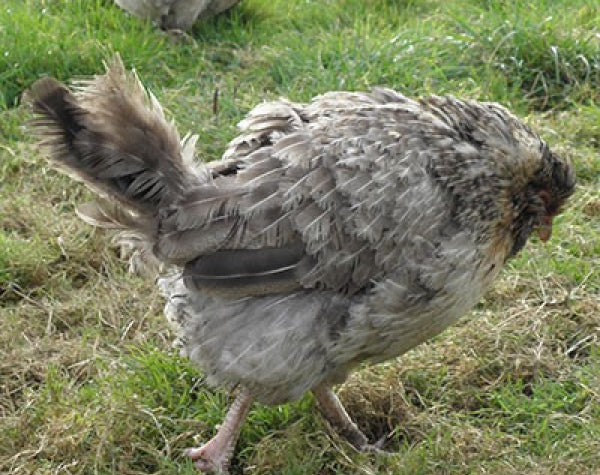What is Scaly Leg Mite?
 Scaly Leg is an infestation caused by a small parasitic mite called Knemidocoptes Mutans - otherwise known as Scaly Leg Mite.
Scaly Leg is an infestation caused by a small parasitic mite called Knemidocoptes Mutans - otherwise known as Scaly Leg Mite.Shocking facts - Scaly Leg Mite is a microscopic mite that burrows under the scales of the legs and feet of a bird. They are grey 8-legged mites with flat, round bodies.
These mites will spend their entire lives on the host, once they have acquired one, burrowing tunnels underneath the skin, reproducing, defecating, and feeding on the connective tissue.
Life Cycle of a Scaly Leg Mite

The mites have a short life cycle of just 10–14 days, so it’s important to treat them quickly. They usually spread through direct contact with infected birds or from contaminated ground. Many breeds of domestic chickens, as well as wild birds, can carry them.
These tiny parasitic pests can survive in damp soil or on the floor of a henhouse. Once they find a host, they burrow under the scales on a bird’s legs or feet, causing pain and irritation. In some cases, they may also affect the comb or wattles.
It’s not only poultry at risk - any bird with scaly legs, including small garden birds, can pick up the mites and bring them into your chicken run.
Recognising Scaly Leg Mite
The mite triggers the bird’s skin to react by producing extra tissue and fluid. This causes the leg scales to lift, making the legs look thick, rough, and bumpy. In many cases, you’ll notice what looks like a white, crusty growth on the leg.
The condition is easy to spot because of the raised scales, even though the mites themselves are almost invisible. In the early stages, they appear as tiny white dots, only about 0.25–0.5mm across.
How does it affect birds?

It is highly contagious and affects birds of all ages, although older birds and feathered-legged breeds tend to be more susceptible.
It is most common in flocks kept on bare earth or damp/wet ground.
Look at this poor Chaffinch (image taken in the Flyte so Fancy garden). It is really suffering, but it's impossible to capture him and treat his legs.
In the early stages, it would appear to cause very little problem, but should it be neglected, the birds lose condition, go lame and have difficulty in perching.
Any treatment of a bad infestation will not be quick; it will require a few weeks of constant treatment until finally the encrustations fall off and the scales return to normal.
See also our AskPhill Video on Dealing with Scaly Leg Mite
How can I treat Scaly Leg Mite in my Chickens?

There are several spray treatments or ointments for birds with a Scaly Leg infestation.
One effective treatment is Nettex Scaly Leg Spray, as it comes in a handheld spray bottle, which makes it easy to apply. It contains ingredients that will smother the mite, soften the hardened scales and soothe the legs. Spray their legs once a week, its natural oils remain on the scales to help prevent further infestation.
Another option is Smite Scaly Leg Spray, which covers the leg in a film that smothers the Mite. Equally, there is Battles Scaly Leg Formula, which again leaves an oily covering on the leg.
This can be more difficult on feather-legged birds, but you must get the spray onto their scales for it to be effective.
Simple Petroleum Jelly (Vaseline) can also be used to smother the mites, although this needs repeated application. Its use will eventually soften the encrustations and then allow contact with the mites to suffocate them.

If you prefer a more natural treatment or repellent, we suggest Barrier Scaly Leg Spray or Barrier Scaly Leg Ointment. They contain natural ingredients, meaning it is suitable for use in organic farming.
The sprays are best used as a deterrent to prevent infestations from recurring - spraying the legs every 1-2 weeks leaves them with a deterrent coating. If you are treating an existing infestation, spray the legs every 5 days to break the egg cycle.
Before such products were available the old-school way was to dip the bird's leg into a jar of surgical spirit, which does kill the mite (but stresses the bird). These days, it is frowned upon (as is dipping it in diesel!). This is very painful for the bird, and therefore, we do not recommend it!
Treating the Chicken Coop and Run for Mites

Having treated the birds, you should also look at their run area and hen house.
We recommend disinfecting the house thoroughly with a purpose-made poultry disinfectant like Virkon-S Disinfectant.
For the ground in their run area, we suggest either Stalosan F Hygiene Powder sprinkled throughout their run on a dry day, or a Ground Sanitising Powder, again, apply in dry conditions.
If their ground is soggy and wet, then consider covering it in a thick layer of Hardwood Woodchip to keep the birds' feet and legs dry. Regular applications of Ground Sanitising Powder should prevent further infections.
I hope this information aids you when treating what has become a relatively common problem for poultry. With the right treatment and some preventative actions, your birds will soon get back to full health.
If you have any further queries, please just Message Us or call our helpline 01300 345229.
- - - -
Scaly Leg Mite in Chickens ©Flyte so Fancy 2013. Updated 2022. Author: Anne Weymouth (Director, Flyte so Fancy Ltd). Reproduction of part or all of this text is only possible with the express permission of Flyte so Fancy Ltd.



